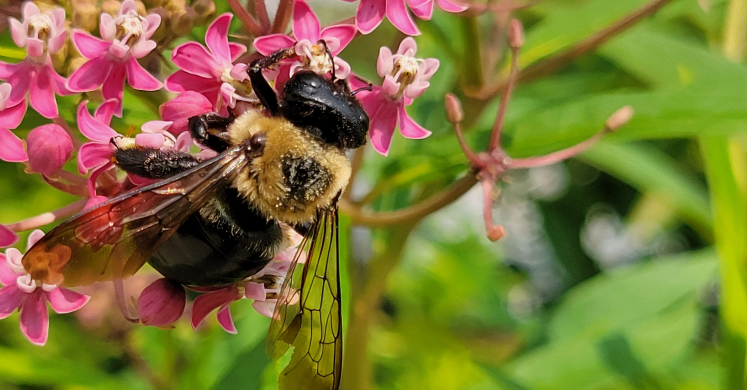Blog

#bioPGH Blog: Carpenter Bees
 A resource of Biophilia: Pittsburgh, #bioPGH is a weekly blog and social media series that aims to encourage both children and adults to reconnect with nature and enjoy what each of our distinctive seasons has to offer.
A resource of Biophilia: Pittsburgh, #bioPGH is a weekly blog and social media series that aims to encourage both children and adults to reconnect with nature and enjoy what each of our distinctive seasons has to offer.
It was mesmerizing the watch. The little carpenter bee deftly worked her way across the top of a milkweed umbel, using her foremost legs as little “hands” to hold on the each tiny flower and investigate for nectar. This was just one of many insects buzzing and fluttering about the grounds of the Center for Sustainable Landscapes, but I was drawn into the moment below.
After this encounter, I went back to do a little research on carpenter bees, but was a bit disappointed to note the most readily available resources were focused on carpenter bees as pests. Certainly their wood-boring abilities may be problematic, but their biology is fascinating as well. Let’s explore a bit!
At first glance, carpenter bees resemble large bumblebees. On closer inspection, one notable difference is that carpenter bees have a smooth abdomen (third body segment) instead of a hairy bumblebee abdomen. Carpenter bees also have hairy legs that catch pollen, rather than the pollen baskets on the legs of a bumblebee. They can be up to an inch long, which certainly could seem intimidating, but males can’t sting and females are generally docile and have to be provoked to sting. Here in Pennsylvania, we only have one large species of carpenter bee, Xylocopa virginica, but there are 35 species across North America and hundreds worldwide!
The carpenter bee’s name comes from the same trait that earned the species a pest status: their wood boring tendencies. Females will chew through wood to create long cylindrical nests called “galleries” in a piece of wood such as a fallen log, fencing, or the side of a house. She will lay an egg in a section of a gallery and then build a little partition wall out of wood pulp to give each egg its own “cell” in the gallery. Before closing up the partitions, female carpenter bees will provide a pollen-and-nectar “bee bread” for each cell to ensure the newly hatched young will have enough to eat (the young will later chew themselves out of their gallery cell!). Notably, even though females may create these nests in the same piece of wood as other females — even directly next to each other — they aren’t cooperating like truly social bees; thus they are still considered generally solitary. And actually, even though carpenter bees are generally solitary, offspring, particularly daughters, may remain with mom until adulthood!
The males typically aren’t behind any wood excavation, but they are most often on our radar because they are the ones who behave defensively near a tunnel, particularly in their territory or if they are waiting to mate with a female. As we mentioned earlier, though, males can’t actually even sting. So while they may buzz around us threateningly, or even dive bomb, they can’t actually cause any harm.
The carpenter bee I found in the milkweed may indeed have had a nest somewhere, and if so, their offspring will most likely hatch and emerge in August, but will probably overwinter in their original gallery they were born in that first year. Carpenter bees can be rather long-lived for insects, with some species living up to three years!
Of course, if you do indeed have carpenter bees causing structural damage, different sources have suggestions for managing the issue (check out the resources below). In general, though, if you spot one of these delightfully chunky bees bobbing along, enjoy their surprising gracefulness and their resourceful abilities!
Continue the Conversation: Share your nature discoveries with our community by posting to Twitter and Instagram with hashtag #bioPGH, and R.S.V.P. to attend our next Biophilia: Pittsburgh meeting.
Penn State Extension: Carpenter Bee
US Forest Service – Carpenter Bees
University of Kentucky – Carpenter Bees
Ohio State University Extension – Carpenter Bees
Kansas State University Research and Extension – Carpenter Bees
All Photos by Maria Wheeler-Dubas

